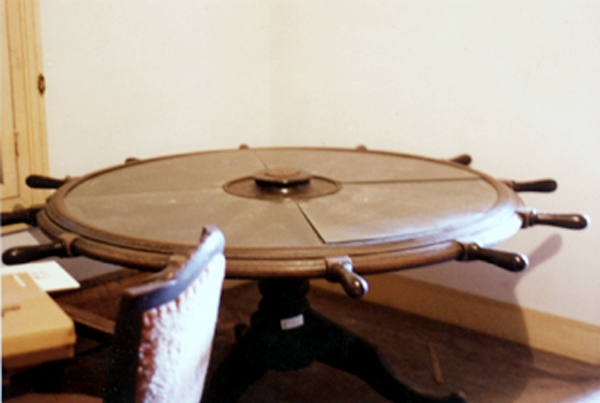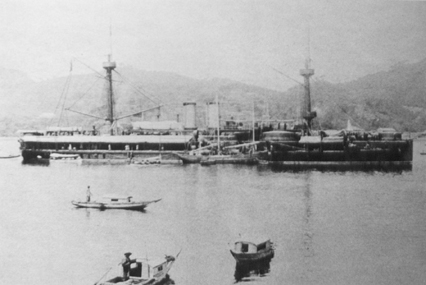
Diameter 155 cm (5.083 feet); wheel revolvable
Photo taken by L Chor, July 1996
 HE SINO-JAPANESE WAR OF 1894-1895 was fought over the control of Korea, nominally
a tributary state of China at the time. China lost all battles on land and at sea. Major battles were
the sea battle of the Yellow Sea, the siege of Pyongyang in Korea, and the siege of Weihaiwei. By the Treaty of
Shimonoseki signed at
Chun fan lou (Shunpanro in Japanese) in April 1895, China had to recognise the "independence" of Korea,
cede Taiwan and neighbouring islands to Japan, and pay an indemnity of 0.23 billion taels of
silver. The war was the first stage of Japan's continental policy of expansion.
HE SINO-JAPANESE WAR OF 1894-1895 was fought over the control of Korea, nominally
a tributary state of China at the time. China lost all battles on land and at sea. Major battles were
the sea battle of the Yellow Sea, the siege of Pyongyang in Korea, and the siege of Weihaiwei. By the Treaty of
Shimonoseki signed at
Chun fan lou (Shunpanro in Japanese) in April 1895, China had to recognise the "independence" of Korea,
cede Taiwan and neighbouring islands to Japan, and pay an indemnity of 0.23 billion taels of
silver. The war was the first stage of Japan's continental policy of expansion.
The major concluding battle of the war was the siege of Weihaiwei in Shangdong peninsula in January and
February 1895, during which Ting Yuan, flagship of the North Ocean Fleet of China, was
hit by one or two torpedoes. Japanese soldiers subsequently boarded the badly damaged ship, took the steering
wheel which fortunately was intact. Admiral ITO Sukeyuki (1843-1914) of the Japaese United Fleet later presented
the steering wheel to Thomas B. Glover (1838-1911), an influential Scottish merchant in Japan at the time
and founder of Kirin beer company. Thomas Glover was then advisor to the giant Mitsubishi shipping line
the merchant ships of which were commissioned to transport army during the war. Probably because
of this Glover received from Admiral Ito the steering wheel of Ting Yuan as a token of appreciation.
With ingenuity, Thomas Glover had a three-legged base fitted to the steering wheel of Ting Yuan, turning
it into a revolving coffee table for his luxury harbour-side home, the Glover House, in the city of Nagasaki.

In the 1970s, this Ting Yuan coffee table was on public display in the living room of Glover House
in Glover Garden,
Nagasaki. It was removed to storage some time afterwards.
Ting Yuan is no more. Like so many historical ironies, because her steering wheel is a trophy
in Japan, at least this pivotal piece which gave direction to the 7,400-ton ironclad turret ship has escaped the fate of becoming rotten wood undersea.


|
Words on the hub of the wheel
"With this Steering Wheel, Safe Sailing Guaranteed
Like an Eagle Flying for Ten Thousand Miles"
--- calligraphy by SAITO Makoto (1858-1936),
Navy Admiral & Prime Minister
of Japan
|
Photo above taken by L Chor, July 1996
 In July 1891, three years before the war,
Admiral Ding Yuchang led Ting Yuan and seven warships
of the North Ocean Fleet to visit Japan. Here Ting Yuan is at anchor in the harbour of Nagasaki.
No one at the time would have ever dreamed that some years later her steering wheel would become
a unique piece of furniture in the hillside residence of Thomas Glover which itself was overlooking the
harbour.
In July 1891, three years before the war,
Admiral Ding Yuchang led Ting Yuan and seven warships
of the North Ocean Fleet to visit Japan. Here Ting Yuan is at anchor in the harbour of Nagasaki.
No one at the time would have ever dreamed that some years later her steering wheel would become
a unique piece of furniture in the hillside residence of Thomas Glover which itself was overlooking the
harbour.
Photo reproduced from Ichioku-nin no Showa shi (Tokyo: Mainichi Shinbunsha, 1977), vol. 13,
p. 13.
ACKNOWLEDGEMENTS
The Gardener's interest in the flagship Ting Yuan was aroused by an illustrated essay
on the Glover Garden
in the book Ri ying xing written by the author Xiao Si (Professor W. L. Lo), who in our subsequent correspondence gave
me most encouraging and heartening comments. The Gardener is also thankful to the Management of the Glover Garden
in Nagasaki for their showing me the steering wheel which in 1996 was not on public display
any more.
TOP
BIBLIOGRAPHY
FRONT PAGE

From the Gardener, Canada, December 1999. Revised July 2015.



 HE SINO-JAPANESE WAR OF 1894-1895 was fought over the control of Korea, nominally
a tributary state of China at the time. China lost all battles on land and at sea. Major battles were
the sea battle of the Yellow Sea, the siege of Pyongyang in Korea, and the siege of Weihaiwei. By the Treaty of
Shimonoseki signed at
Chun fan lou (Shunpanro in Japanese) in April 1895, China had to recognise the "independence" of Korea,
cede Taiwan and neighbouring islands to Japan, and pay an indemnity of 0.23 billion taels of
silver. The war was the first stage of Japan's continental policy of expansion.
HE SINO-JAPANESE WAR OF 1894-1895 was fought over the control of Korea, nominally
a tributary state of China at the time. China lost all battles on land and at sea. Major battles were
the sea battle of the Yellow Sea, the siege of Pyongyang in Korea, and the siege of Weihaiwei. By the Treaty of
Shimonoseki signed at
Chun fan lou (Shunpanro in Japanese) in April 1895, China had to recognise the "independence" of Korea,
cede Taiwan and neighbouring islands to Japan, and pay an indemnity of 0.23 billion taels of
silver. The war was the first stage of Japan's continental policy of expansion.



 In July 1891, three years before the war,
Admiral Ding Yuchang led Ting Yuan and seven warships
of the North Ocean Fleet to visit Japan. Here Ting Yuan is at anchor in the harbour of Nagasaki.
No one at the time would have ever dreamed that some years later her steering wheel would become
a unique piece of furniture in the hillside residence of Thomas Glover which itself was overlooking the
harbour.
In July 1891, three years before the war,
Admiral Ding Yuchang led Ting Yuan and seven warships
of the North Ocean Fleet to visit Japan. Here Ting Yuan is at anchor in the harbour of Nagasaki.
No one at the time would have ever dreamed that some years later her steering wheel would become
a unique piece of furniture in the hillside residence of Thomas Glover which itself was overlooking the
harbour.


